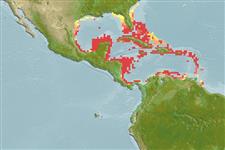Common names from other countries
>
Holocentriformes (Squirrelfishes, soldierfishes) >
Holocentridae (Squirrelfishes, soldierfishes) > Holocentrinae
Etymology: Sargocentron: Greek, sargos = sargus + Greek, kentron = sting (Ref. 45335).
More on author: Poey.
Environment: milieu / climate zone / depth range / distribution range
Ecologie
marien rifbewoner; diepte 1 - 30 m (Ref. 9710), usually ? - 22 m (Ref. 3156). Tropical; 33°N - 7°N, 99°W - 58°W
Western Atlantic: Bermuda and Florida, USA to northern South America.
Grootte / Gewicht / Leeftijd
Maturity: Lm ? range ? - ? cm
Max length : 15.0 cm TL mannelijk / geslacht onbekend; (Ref. 26340)
Dorsale stekels (totaal) : 11; Dorsale zachte stralen (totaal) : 12; Anale stekels: 4; Anale zachte stralen: 8. Body slender, sides compressed. Snout spinules prominent, spine extending into the posterior narial opening. White stripes on upper sides narrow, separated by broader dark bands (Ref. 37108). Body with alternate stripes of red and silvery white; spinous dorsal fin red, white at tips, with a large black spot between the first 3 or 4 spines (Ref. 13442).
Inhabit sandy, rocky and coral bottoms (Ref. 5521). More common on seaward reefs than on protected reefs. Retreat into recesses when alarmed (Ref. 9710). Nocturnal (Ref. 37108). Secretive, found deep in crevices between branches of live corals (Ref. 26938). Oviparous, with planktonic eggs and larvae (Ref. 240).
Levenscyclus en paargedrag
Maturities | Voortplanting | Spawnings | Egg(s) | Fecundities | Larven
Smith-Vaniz, W.F., B.B. Collette and B.E. Luckhurst, 1999. Fishes of Bermuda: history, zoogeography, annotated checklist, and identification keys. American Society of Ichthyologists and Herpetologists Special Publication No. 4. 424 p. (Ref. 35505)
Status op de Rode Lijst van het IUCN (Ref. 130435)
CITES (Ref. 128078)
Not Evaluated
Gevaar voor de mens
Reports of ciguatera poisoning (Ref. 30303)
Gebruik door de mens
Visserij: commercieel
Tools
Speciale rapporten
Download XML
Internetbronnen
Estimates based on models
Preferred temperature (Ref.
115969): 25.3 - 28.1, mean 27 (based on 158 cells).
Fylogenetische diversiteitsindex (Ref.
82804): PD
50 = 0.5000 [Uniqueness, from 0.5 = low to 2.0 = high].
Bayesian length-weight: a=0.01445 (0.00900 - 0.02322), b=2.98 (2.84 - 3.12), in cm Total Length, based on LWR estimates for this species & Genus-body shape (Ref.
93245).
Trofisch niveau (Ref.
69278): 3.6 ±0.5 se; based on diet studies.
Weerstandsvermogen (Ref.
120179): Hoog, minimale populatieverdubbelingstijd minder dan 15 maanden (Preliminary K or Fecundity.).
Fishing Vulnerability (Ref.
59153): Low vulnerability (10 of 100).
